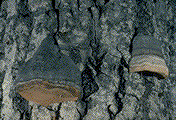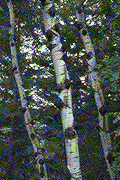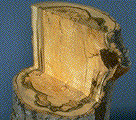Archived Content
Information identified as archived on the Web is for reference, research or recordkeeping purposes. It has not been altered or updated after the date of archiving. Web pages that are archived on the Web are not subject to the Government of Canada Web Standards. As per the Communications Policy of the Government of Canada, you can request alternate formats on the Contact Us page.
Aspen Trunk Rot
Phellinus tremulae (Bondarzev) Bondarzev & Borisov in Bondarzev
(= Fomesigniarius (L.:Fr.) J. Kickx. fil. f. tremulae Bondarzev)
(= Fomes igniarius var. populinus (Neuman) Camp.)
Basidiomycotina, Aphyllophorales, Polyporaceae
Hosts:Phellinus tremulae is found only on trembling aspen.
Distribution: This fungus is widely distributed throughout the range of its host in B.C.
Identification: The fruiting bodies are perennial, hard, woody, up to 20 cm wide and 15 cm thick, and generally triangular shaped in longitudinal section (Figs. 21a, 21b). The fruiting bodies differ in shape from those of P. igniarius; the upper and lower surfaces of P. tremulae are at angles of about 45° from horizontal, whereas P. igniarius conks are hoof-shaped with the lower surface close to horizontal. The upper surface is deeply zoned, grey-black to black and roughened when old. The lower surface is brown and poroid; the pores are small and regular in outline. The context is rust-brown; old tubes are in distinct layers, and are filled with white mycelium that appears as white streaks. Fruiting bodies form in association with branch scars on living and dead standing trees and on slash. Black, sterile mycelial masses commonly called sterile conks, blind conks, or punk knots also form at branch scars (Fig. 21c).
The early stage of the decay appears as a yellow-white zone in the heartwood, usually surrounded by a yellow-green to brown margin. In the advanced stage the soft yellow-white wood usually contains fine black zone lines running throughout; zone lines also usually surround the decay column (Fig. 21d).
Microscopic Characteristics: Hyphae in the context of the fruiting body of two types: thick-walled, simple septate, dark reddish-brown, and thin-walled, pale-yellow to hyaline, with simple septa. Hymenial setae present, 12-30 x 6-7.5 µm. Basidiospores subglobose, hyaline, smooth, IKI-, 4.5-5 x 4-4.5 µm. Growth in culture slow, mat white, becoming buff, then brown, laccase positive, strong odour of wintergreen. Stalpers: 1 3 4 (9) (10) (11) (12) (13) (14) (15) (17) 21 22 (25) (26) 28 (30) (31) (34) 35 36 (38) (46) 48 51 52 53 64 67 (80) 83 89.
Damage: Aspen trunk rot is one of the most serious problems limiting the utilization of mature aspen in western Canada. The presence of a single fruiting body generally indicates a considerable volume of decay, as much as 82% of gross tree volume. Unfortunately, there are often no external indicators of decay, and it is difficult to predict decay volumes. Volume losses increase significantly with tree age.
Remarks:Phellinus tremulae, was once considered as a part of the Phellinus igniarius complex, but is now recognized as distinct species. It occurs exclusively on aspen, and is the most damaging decay fungus associated with the tree species. Decayed wood in fresh cut trees has a distinct wintergreen odour.
References:
DeByle, N. V. and R. P. Winokur (eds). 1985. Aspen: ecology and management in the western United States. USDA For. Serv., Gen. Tech. Rep. RM-119.
Gilbertson, R. L. and L. Ryvarden. 1987. North American Polypores. 2:614. Fungiflora, Oslo.
Hinds, T. E. and E. M. Wengert. 1977. Growth and decay losses in Colorado aspen. USDA For. Serv., Res. Paper RM-193.
Hiratsuka, Y. and A. A. Loman. 1984. Decay of aspen and balsam poplar in Alberta. Can. For. Serv., Inf. Rep. No. NOR-X-262.
Figures
Click on any image to see the full size version.
Press "Back" on your browser to return to this screen.

Figure 21a: Fruiting bodies of Phellinus tremulae.
 Figure 21b: Fruiting bodies of Phellinus tremulae.
Figure 21b: Fruiting bodies of Phellinus tremulae.
 Figure 21c: Aspen trees with "blind conks."
Figure 21c: Aspen trees with "blind conks."
 Figure 21d: Cross- and longitudinal-section of decayed aspen stem infected with P. tremulae (note conk).
Figure 21d: Cross- and longitudinal-section of decayed aspen stem infected with P. tremulae (note conk).
 This Web page has been archived on the Web.
This Web page has been archived on the Web.